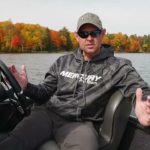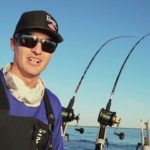Southern Muskies
Muskie guide Chad Cain of Illinois says that if a
muskie angler plays their cards right, southern waters
can help them chase muskies virtually year round!
For many years, muskies were considered to be the ferocious predators of the Northwoods. Many vacationers packed there bags and headed to Wisconsin, Minnesota, Michigan, and Canada to chase this elusive toothy critter. Times are changing though, and through extensive stocking programs, the southern range of the muskie world is starting to turn some heads.
Thats a Southern Ski!The single greatest attribute to southern muskie waters is that it now offers muskie fisherman an opportunity to chase their favorite species almost year round. Muskie waters such as Lake Kinkaid in southern Illinois, Lake Shelbyville in central Illinois, Pomme de Terre in Missouri, and the Cave Run and Green River reservoirs in Kentucky typically start producing in mid February and won’t freeze up again until January.
The waters in the southern range of the muskie world have no closed seasons on them unlike their counterparts from the Northwoods. The muskie populations in the southern waters are sustained through aggressive stocking programs. Unfortunately, there is no natural reproduction or very limited reproduction at best on these waters, so stocking is the only way to go. That is why there is no closed season in order to protect them. Believe me, if there were significant reproduction occurring, I would be the first person knocking on the Department of Natural Resources door asking for a closed season. Since there isn’t, anglers can take advantage of this and chase some extremely fat muskies.
These bodies of water also provide the angler with an opportunity to catch some very large muskies. A trip to these southern waters may produce the largest fish of the season for you. Fish over the thirty-pound mark are a definite possibility, and fourty-pound muskies are also present in these waters.
The only drawback to these southern waters is that they experience very hostile environments during the summer months. Water temperatures reach all the way into the low 90-degree range on these reservoirs, so fishing for muskies on these waters in the summer months is not recommended. It seems that muskies cannot tolerate these extreme temperatures and the added stress of angling for them is usually lethal. Typically the months of July and August are the hottest, but it is a good idea to leave them alone from the middle of June until the middle of September. Fortunately though, this is when the muskie waters of the Northwoods are in their prime.
For the muskie fisherman that wants to fish year round, head to the southern waters from February to mid June, fish the Northwoods until the middle of September, and head back down south and fish until the beginning of January. What more can a muskie fisherman ask for? While most fisherman from the north are sitting on a bucket on a frozen pond staring at a tip-up or a tiny bobber in the winter and early spring, we are out slinging muskies baits over open water. It doesn’t get any better than that. The true cure for cabin fever has been prescribed.
 Now that some of you have probably already packed your suitcases and are about to hook up the boat to head south, lets look at what it takes to catch these southern muskies.
Now that some of you have probably already packed your suitcases and are about to hook up the boat to head south, lets look at what it takes to catch these southern muskies.
Starting off with the beginning of the year, the February and March time frame on these waters is the pre-spawn time of year. This is when the muskies are the absolute fattest that they will be throughout the entire year.
Although the water temperatures are on the cool side ranging from 40 to 55 degrees, muskies are feeding quite actively in order to provide energy for egg maturation and sperm development for the upcoming spawn.
The first place to start when searching for pre-spawn muskies is near feeder creeks and headwaters of these reservoirs. This is where the majority of muskies congregate to spawn. This is also where the warmest water is in the early part of the year as things start to heat up.
Presentations that work are twitched crankbaits such as the 8″ and 10″ Jake from Musky Mania Tackle and the Shallow Invaider from Musky Innovations. Jointed crankbaits such as the Swim Wizz and Believer, as well as the new Jointed Lazer Eye crankbaits from Bass Pro shops seem to be the hottest ticket. Jerkbaits that work well are the Jerko and Squirko from Llungen Lures, and the Magic Maker from Musky Mania Tackle. The water is usually murky near these headwaters and feeder creeks, so brightly colored baits work the best.
In the months of April and May on these southern waters, a wide variety of lures work well. The muskies head out of the spawning areas and head to either the weed-beds or coves with flooded timber. The primary forage on most of these waters is gizzard shad, and this is the time frame when the shad are spawning in shallow water near weeds and the back of the stump filled coves. Top-waters such as the Doc from Musky Mania Tackle, the Pacemaker from Sennett Tackle, and a Grim Reaper buzz bait can be very effective at this time because the water is usually anywhere form 60 to 70 degrees. Other lures that work well at this time is bucktails and spinner baits. Some of the best are the Flasher from Shumway Tackle, and the Lilly Tail from Musky Mania Tackle. Spinner baits that work well are the Grim Reapers and the Funky Chickens from Shumway Tackle.
The first half of June is usually fishable on these southern waters, before the water temperatures reach 80 degrees. By then, the shad have finished spawning, and move out and suspend in open water. Once the shad go out and suspend, so do the majority of the muskies. Open water trolling is very effective at this time. Favorite lures to troll are the 10″ Jake, the 9″ Ernie, and the Lazer Eye crankbaits.
Remember, during the summer months from mid June to mid September, leave these southern waters alone and head up north. Mortality levels are way too high to fish during the hot water period.
Once the water has cooled off again by mid September, fishing can be very awesome at this time. The tactics that worked well in April and May also work well during September and October on the southern waters.
Once November and December rolls around, water temperatures range from the 60’s in November, and the 50’s in December. Most of the fish are still around the weed-beds and stump filled coves, and the tactics that work best are twitching crankbaits such as the 8″ and 10″ Jake, as well as jerk-baits such as the Bull Dawg from Musky Innovations, the Jerko from Llungen Lures, and the Magic Maker.
Now that muskie fisherman have the opportunity to fish year round, take advantage of this and head south in the spring, late fall, and early winter. Eliminate cabin fever altogether, and battle with some of these southern toothy critters. You will not be disappointed, and like I stated earlier, you may end up with your biggest fish of the year out chasing southern muskies.





